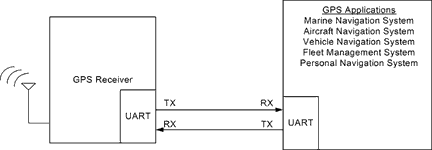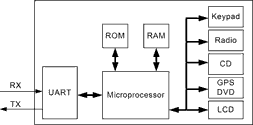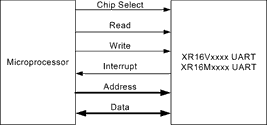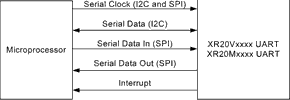
GPS has traditionally been used in military applications such as marine navigation, aircraft navigation, and weapon’s guidance. However, GPS applications have recently expanded to industrial and consumer applications such as vehicle navigation systems, fleet management, and personal navigation.
This article describes where an Exar UART can be used in a global positioning system (GPS) application.
In industrial and consumer applications, the Exar UART can be used in the GPS receiver and in the GPS application. GPS application examples are shown in Figure 1.

A GPS receiver typically includes the following: an RF block for receiving the GPS data and converting it to digital data; microprocessor for processing the data; ROM to store the firmware for processing the data; RAM used by the microprocessor for data processing; UART to send data to the GPS application.
Figure 2 shows a block diagram of a GPS receiver and Figure 3 shows a block diagram of an automobile GPS navigation system.


The UART that has been used in the GPS receiver or in the GPS application, has typically been an industry standard 16550 UART or a UART that is available on the microprocessor. In place of the standard UART, an enhanced Exar UART can be used to replace the UART on both the GPS receiver and GPS application to increase performance and data throughput. If the microprocessor has a local 8-bit (Intel or Motorola) bus interface, then any of the XR16Vxxxx or XR16Mxxxx high performance UARTs can be used (Figure 4).

If the microprocessor has either an SPI or I²C bus interface, then any of the XR20Mxxxx or XR20Vxxxx I²C/SPI UARTs can be used (Figure 5). In the case that a microprocessor has a PCI bridge, then any of the XR17xxx PCI UARTs can be used (Figure 6).


The advantages of using an enhanced Exar UART in a GPS application are the following:
* Higher data throughput:
The data throughput can be significantly increased as the maximum baud rate is 16 Mbps. The maximum baud rate for a UART on existing GPS receivers range from 4800 bps up to 115,2 Kbps. For example, assuming that each byte is 10 bits long (one start bit, eight data bits, no parity, one stop bit), it would take approximately 10 milliseconds to send 128 bytes of data at 115,2 Kbps. With Exar's UART operating at 16 Mbps, it would only take 80 μs to send the same data.
* Larger FIFOs:
To support the higher data rates, Exar UARTs have larger FIFOs to reduce the servicing time between interrupts to allow the microprocessor more time to perform other tasks.
* Automatic flow control:
To prevent data overrun errors, Exar UARTs have automatic hardware (RTS/CTS) flow control and software (Xon/Xoff) flow control features that can be enabled. Current GPS applications do not use any flow control features resulting in slower baud rates.
* Fractional baud rate generator:
The industry standard 16550 UART requires a standard clock or crystal to generate standard baud rates. With the fractional baud rate generator feature of enhanced Exar UARTs, that is no longer a requirement. The enhanced Exar UART can generate any standard or custom baud rate with any clock frequency. Therefore, any existing clock source on the board (such as the clock used by the microprocessor) can be used by the Exar UART resulting in reduced board costs.
* Wide operating voltage range:
The XR16Mxxxx and XR20Mxxxx UARTs can operate from 1,62 V to 3,63 V, the XR16Vxxxx and XR20Vxxxx UARTs can operate from 2,25 V to 3,63 V and the XR17xxxx (PCI) UARTs can operate 3,3 V.
* Lower power consumption:
In addition to lower operating voltages, Exar's enhanced UARTs have a sleep and/or PowerSave mode to further conserve power when the UART is not being used. In the sleep/PowerSave mode, the power consumption is less than 30 μA at 3,3 V and less than 15 μA at 1,8 V. This feature would be ideal in extending the battery life for portable/handheld applications.
* Small package footprint:
Most Exar UARTs are available in a leadless QFN package (as small as 4 X 4 X 0,9 mm) to optimise the use of board space in space-constrained applications.
Conclusion
Any existing or new GPS application can be improved by using an enhanced Exar UART. Exar's UARTs have enhanced features that can increase data throughput while preventing data loss and data errors. Exar's enhanced UARTs can easily be interfaced with any microcontroller that has an 8-bit (Intel or Motorola) bus interface, an I²C/SPI interface or a PCI interface.
| Tel: | +27 11 315 8316 |
| Email: | [email protected] |
| www: | www.asic.co.za |
| Articles: | More information and articles about ASIC Design Services |

© Technews Publishing (Pty) Ltd | All Rights Reserved